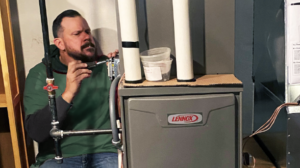
December 2022
Read Time: 3-4 Minutes
Reduce Heating Bills with These 4 Tips
It’s easy to love winter as a kid, but as we age into adulthood, the season can lose its shine. Suddenly, cooler weather isn’t a welcome sign of snow days and oncoming holiday festivities; instead, it’s a warning to expect icy roads, early-morning shoveling and — perhaps most importantly — high heating bills.
Utility costs are always stressful to budget for. However, this year is shaping up to be particularly hard to afford, thanks to increasing fuel costs and colder weather patterns. According to recent projections from the U.S. Energy Information Administration (EIA), heating bills in 2022-2023 will be around 28% more expensive than last winter. Analysts expect higher prices to roll out across all fuel sources, from gas ($15.95 per thousand cubic feet) to propane ($2.32-$3.45 per gallon), electricity ($0.14 per kilowatt-hour), and oil ($4.54 per gallon).
“Everyone wants to look forward to the holiday season, but rising utility costs can become a real source of stress when the weather gets chillier,” Service Manager Tim Helms at Kettle Moraine Heating and Air Conditioning, shared in an interview. “It’s hard to enjoy the festivities when you’re worried that you won’t be able to keep your family warm through the winter.”
Fortunately, families can take a few preemptive actions to reduce their heating bills and stay warm through winter. However, Tim Helms says, households need to start taking those steps now before the season arrives in full force.
“You don’t want to start thinking about this when it’s below freezing, and icicles are forming on your front porch,” he said. “It’s better to make your preparations before you have to choose between a freezing house and high energy bills.”
#1: Cut down on drafts and heat loss by sealing your windows

It’s intuitive: a cracked cup will leak no matter how much water you pour into it. The same logic applies to household heat; if your windows and doors aren’t properly sealed, warmth from your home will inevitably seep into the outside world. This seepage can lead to higher energy costs, lower heating efficiency, and cold or drafty rooms.
“Most kids have probably heard their dad say, ‘I’m not paying to heat the outdoors!’ when they leave the door open too long,” Tim said. “And hey, Dad has a point. No one wants to pay an arm and a leg for heat that’s disappearing out the front door or through gaps in the window frame.”
Thankfully, there’s an easy and affordable solution to heat seepage: window sealing. Window-sealing creates an airtight seal around leak-prone areas so your family can stay warm without cranking up the heat. There are a few different ways to approach sealing. Some families use window film — a sheet of shrink-wrap plastic stretched across the window frame to keep out the cold — to retain heat. Others use more subtle window insulation foam or sealing strips to create an airtight seal. If you dislike the look of these conventional methods, Tim suggests investing in a set of thermal curtains or blinds.
#2: Use an electric blanket or space heater at night

Why heat the entire house when you only need a room or two to stay warm overnight? Being more intentional and strategic about how you heat your home through the night can save you a significant amount of money. Purchasing an electric blanket or inexpensive space heater to use in conjunction with your heating system can help you regulate temperature without wasting heat.
“Let’s say you like keeping the house at 70 degrees during the winter,” Tim hypothesized. “That’s fine during the day — but at night, that’s hours of warmth you’re paying for and not using. But if you have an electric blanket or space heater, you can bump the thermostat down to 63 or 65 degrees and remain warm overnight.”
#3: Make sure your furnace filter is in good condition
Intuitively, it makes sense to cycle your home’s furnace filters; after all, no one wants to breathe dirty air. But there’s another reason homeowners should care, Tim says. “When your air filter is dirty or clogged, your furnace needs to work harder to circulate the same amount of heat,” he said. “That extra effort will naturally increase your heating bill.”
How often you replace your filter will depend on your system, and the filters it uses. For example, a single-inch filter should be changed once every three months, while a three or four-inch filter should be changed every six to nine months.
The best way to determine if your filter needs to be replaced is to take a look for yourself, preferably ahead of the heating season. If it’s gray and covered in dust or other debris, then it’s time for an energy-saving change.
#4: Invest in an energy-efficient furnace

At first, investing in a new furnace might not feel like the most appealing prospect for cash-strapped homeowners — but sometimes, it just has to be done.“Every furnace has a lifespan,” Tim said. “Even if your furnace has served you well for 10, 12, or even 18 years, there will eventually come a time when it’s no longer up to the challenge of keeping your family warm through the winter.”
Older furnaces tend to burn more fuel and cost more to use and repair than newer models. And, as they grow older, legacy furnaces lose their efficiency — which can result in higher energy costs and chillier rooms. When this deterioration occurs, it may be time to consider replacing your old furnace with an energy-efficient version.
Conventional furnaces have an Annual Fuel Utilization Efficiency (AFUE) rating of about 80%. In layperson’s terms, this means that 80% of the fuel becomes heat, while 20% dissipates as exhaust. An efficient (“condensing”) furnace, however, maintains a secondary exchanger that distills heat from exhaust gasses that would have otherwise escaped through a chimney or vent. Per EPA regulations, high-efficiency furnaces must have an AFUE of at least 90%.
“A new furnace can be a game-changer,” says Tim. “Since they use less energy, a high-efficiency model could help you save up to 50% on utility bills and reduce harmful greenhouse gas emissions. It’s a win-win.”
High-efficiency models provide other benefits, too. Condensing furnaces are designed to last; all models feature built-in systems that prevent damaging moisture from accumulating within the heat exchanger, as well as economical on-and-off cycling systems that extend their active lifespans.
“Yes, there is an upfront cost involved,” Tim said. “But the investment is worth making, especially given rising energy prices and the potential for a recession. If you have an old, inefficient furnace, you should consider replacing it before it fails entirely.
“Making smart, strategic decisions early can save you a lot of money in the long run — and help you make sure that your family stays warm all season,” he concluded.
For more information on our current furnace offerings and solutions for Wisconsin homeowners, please visit KettleMoraineHeating.com/specials.





